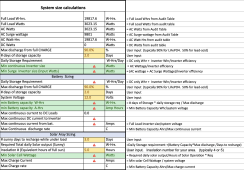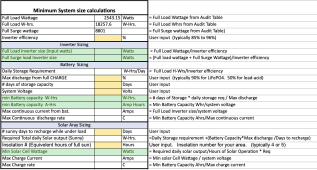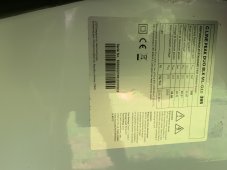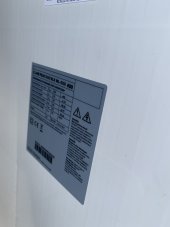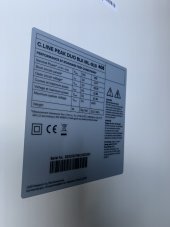What size of chest freezer? My 7.2 cu ft Danby freezer only uses 50-60 watts running every 15-20 minutes for about 5 minutes (0 watts not running) and has a guesstimated surge of abut 600 watts (viewed as a spike on my Poniie energy meter when I watched it kick on. I don't yet have a clamp meter capable of measuring in rush current but it's on my tool list when I can afford it. By the freezer's smart plug energy monitor app, it shows power consumption on average over the last 6 months at 11.40 KWh per month. Your chest freezer at 400 watts running watts seems 10x higher than mine? So trying these appliances out with an Energy Monitor device or even a smart plug with energy monitoring will help you size your system.
I don't have a mini split but after looking at half a dozen YouTube videos to learn something about them, I have yet to see one around the same size as your Senville mentioned that has a surge of 4800 watts. That seems extremely excessive but if it is accurate, then you need to find an inverter than can in fact handle a 4800 watt surge, (plus whatever else may be running at the time eg: 4800 watts plus 1200 watt coffee maker? plus laptop, plus LED lights?) However, from the videos, the Senville seems to maybe have a starting surge of 1,000 watts and about 950 watts running until it reaches it's target temperature settings and then only 50-100 watts while maintaining it's settings and below 10 watts in idle.
The one video on the Senville mini split says that he has a 5 KWh (5,000 Watt) battery that can run the mini split for 24 hours before depleting the battery. If you wanted an extra day of poor solar production, then you may want to size your battery to be 10+ KWh. It's not that linear though, as you will also have other appliances to use and or you could really scrimp on your power consumption to try to get the watts used more sporadically in your personal survivor mode. Heating / Cooling are your biggest power draws unless you super insulate your Tiny Home (which would be desirable anyway, if possible).
Will Prowse EG4 Mini-Split Video
Senville Mini-Split Energy Use Video
https://www.youtube.com/watch?v=cF-7XkXP7RU
Presently it's cloudy. Cloudy day = Poor Solar. My 2280 Watt array at 10 a.m. and cloudy is only producing 150 watts or roughly just 6.7% of it's 2280 capacity. But I am also not running any high power demand loads, basically only 70 watts, so I have the remaining solar of 80 watts charging the battery. If I had a 720 mini split running at 720 watts, then I would be drawing down my battery at 570 watts continuously (720-150 watts) when my solar production is only 150 watts. Or if you used a Solar Panel DC capable mini split such as the EG4, then your panels could not run the mini split until your panels were receiving 720+ watts of sunshine, so your batteries would have to help make up the difference.
So if you choose not to accurately measure or find info of appliances like yours accurately measured, such as on maybe YouTube, then by guessing you may need:
Solar Panels: 6 x 430 Watts = Okay minimum
Inverter: 4000 Watt+ inverter to handle your guessed 4800 surge (BE careful of inverter HYPE as some inverters over hype their capabilities and most don't even mention what type of "motors" or in rush current they handle. A good quality Low Frequency inverter is recommended or get the reseller or manufacturer to comment on your appliances OR ACCURATELY MEASURE your appliances in use).
Battery: 5 Kw LiFePO4 capacity at minimum, 10-15 KWhr desirable.
Solar Charge Controller: Would need to be sized based on how you wire your solar panels. Eg: I have 6 x 380 watt panels that are wired as 3S (3 in Series) + 2P (2 in Paralllel) - creates a maximum of 79.2 Charging Amps at 28.8 degrees Celcius and 135 Volts (VOC) at a max low of -35 degrees Celcius, so I sized my MPPT Solar Charger Controller to be: 150 Volt / 85 Amps Victron.
My 24 volt system would easily be able to handle your loads, but my battery capacity is too low for overnight or cloudy or cloudy winter days as there isn't enough reserve capacity at 100 AHrs but could handle your loads when it were 100% sunny.
Inverter: 4000 Watt Xantrex (20+ years old - 95% Efficient, 16 Watts idle power use (on 24/7)
Solar Charge Controller: 150V/85 Amp Victron MPPT
Battery: 100 AHr 24Volt LiFePO4 Battery with an Active Balancer BMS (you would need 5-10x this for 24 hour mini split use and for cloudy days + a backup fossil fuel generator like a 2000 watt Honda inverter gasoline generator).
6 x 380 Watt BiFacial Solar Panels
(Plus cables, lugs, bus bars, DC breakers, DC breaker boxes, DC Disconnects, Battery Cable Fuses, Battery Monitoring, plus build tools)
A 48 Volt system would be helpful but research the inverter for the minimum energy use (some call it parasitic load), some All in One units use 70 watts just to be on. Some inverters also don't like to be turned On/Off on a continuous basis.
You may be able to get by with a smaller inverter than 4,000 watts depending on the in rush current of your loads and or how many appliances you want to run at the same time. But personally, I would not go lower based on my usage and I only have minimal needs but my inverter seems to handle everything with ease.
You have enough solar panels to recharge a 5-10 KWhr battery will handle the loads you list. You will need a very good inverter and charge controller. As the saying goes: "Buy Once, Cry Once". Anyway, hope this food for thought.




